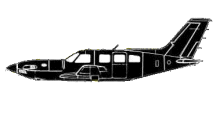
ASN Wikibase Occurrence # 294008
This information is added by users of ASN. Neither ASN nor the Flight Safety Foundation are responsible for the completeness or correctness of this information.
If you feel this information is incomplete or incorrect, you can submit corrected information.
| Date: | Tuesday 15 March 2005 |
| Time: | 15:10 LT |
| Type: |  Piper PA-46-500TP |
| Owner/operator: | Private |
| Registration: | N504SR |
| MSN: | 4697165 |
| Year of manufacture: | 2003 |
| Total airframe hrs: | 186 hours |
| Engine model: | Pratt & Whitney PT6A-42A |
| Fatalities: | Fatalities: 0 / Occupants: 2 |
| Aircraft damage: | Substantial |
| Category: | Accident |
| Location: | Flagstaff, Arizona -
 United States of America United States of America
|
| Phase: | Unknown |
| Nature: | Private |
| Departure airport: | Heber, UT (36U) |
| Flagstaff-Pulliam Airport, AZ (FLG/KFLG) | |
| Investigating agency: | NTSB |
| Confidence Rating: |
The airplane veered off the left side of the runway during the landing roll and the nose landing gear collapsed upon impact with a snow bank. The pilot reported that the airplane touched down normally on the main landing gear, but when the nose landing gear touched down the airplane veered suddenly and violently to the left. He believed the nose landing gear was not responding to normal control inputs. The tire and skid marks on the runway were consistent with the pilot's statement and showed that the airplane's track diverged in excess of 70 degrees from the runway centerline just after nose wheel touchdown. Examination of the tires disclosed that the nose tire was scrubbed perpendicularly to the tire tread from right to left. No flat spots or other unusual signatures were observed on the main tires or the brakes. Post accident investigation of the nose landing gear system revealed the bolt that attaches the hydraulic actuator to the engine mount was sheared and the nose gear steering arm was fractured. Examination of the steering arm revealed it met the manufacturer's specifications and its failure, along with the bolt, was determined to be overload. Examination of the steering bungee revealed no obvious anomalies. According to the airplane manufacturer, there were 32 prior reports of temporary and unexplained loss of directional control immediately following nose wheel touchdown during landings, primarily when crosswind conditions are present and/or when applying full propeller reverse. Investigation of those events by the manufacturer's engineering department found that a contributing cause of the directional control problems was identified as insufficient nose gear steering authority, which under certain conditions, can allow the nose gear steering system rotation to momentarily exceed the pilot's input. The manufacturer issued a service bulletin, which recommended the incorporation of nose gear installation modifications. The modifications were intended to increase the pilot's steering authority and remedy the directional control problems. According to manufacturer, the accident airplane was manufactured after all of the nose gear modifications were implemented on the production line.
Probable Cause: the loss of directional control during landing for undetermined reasons.
Accident investigation:
 |
|
Sources:
NTSB LAX05LA116
Revision history:
| Date/time | Contributor | Updates |
|---|---|---|
| 10-Oct-2022 16:12 | ASN Update Bot | Added |
Corrections or additions? ... Edit this accident description
The Aviation Safety Network is an exclusive service provided by:


 ©2024 Flight Safety Foundation
©2024 Flight Safety Foundation